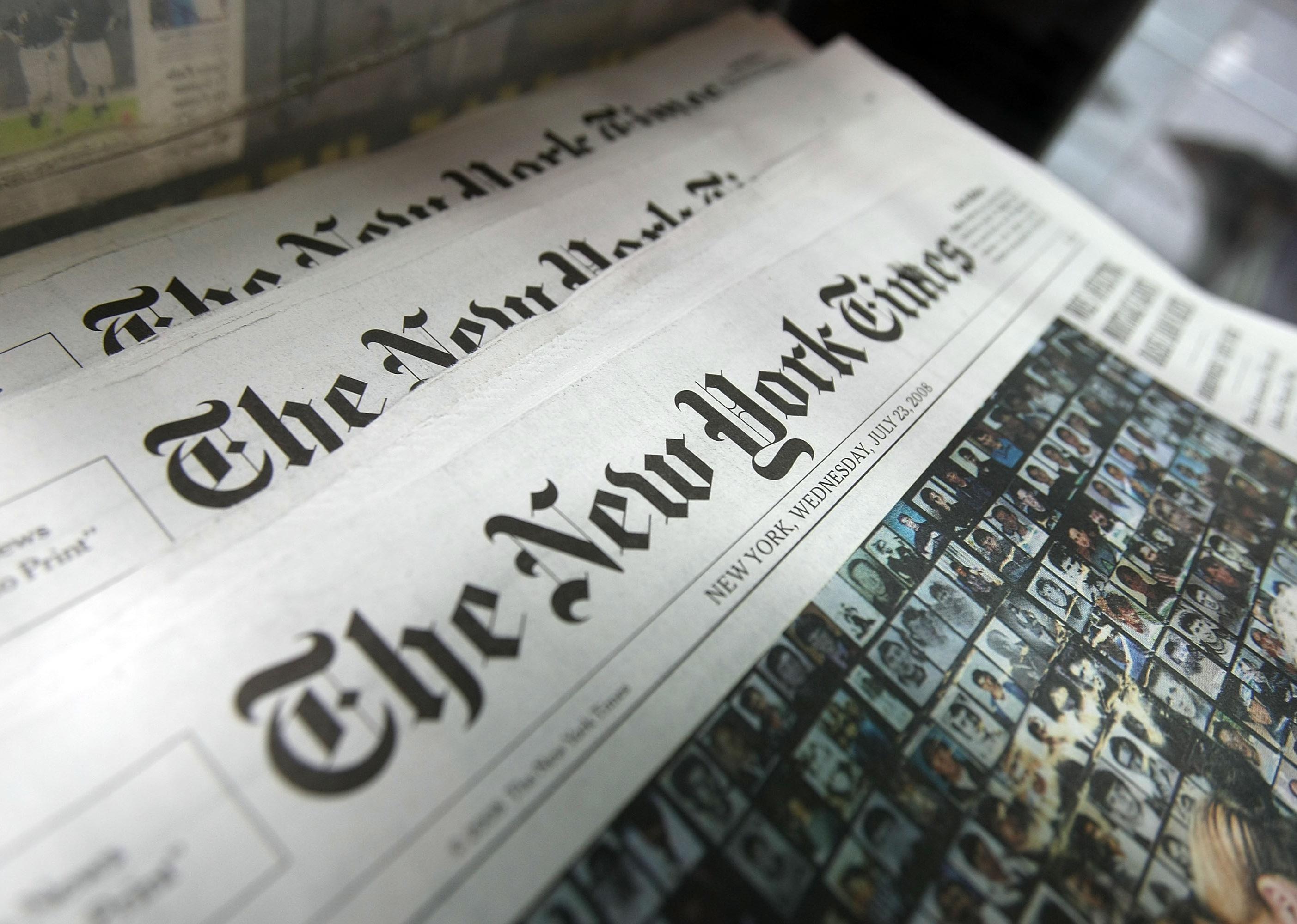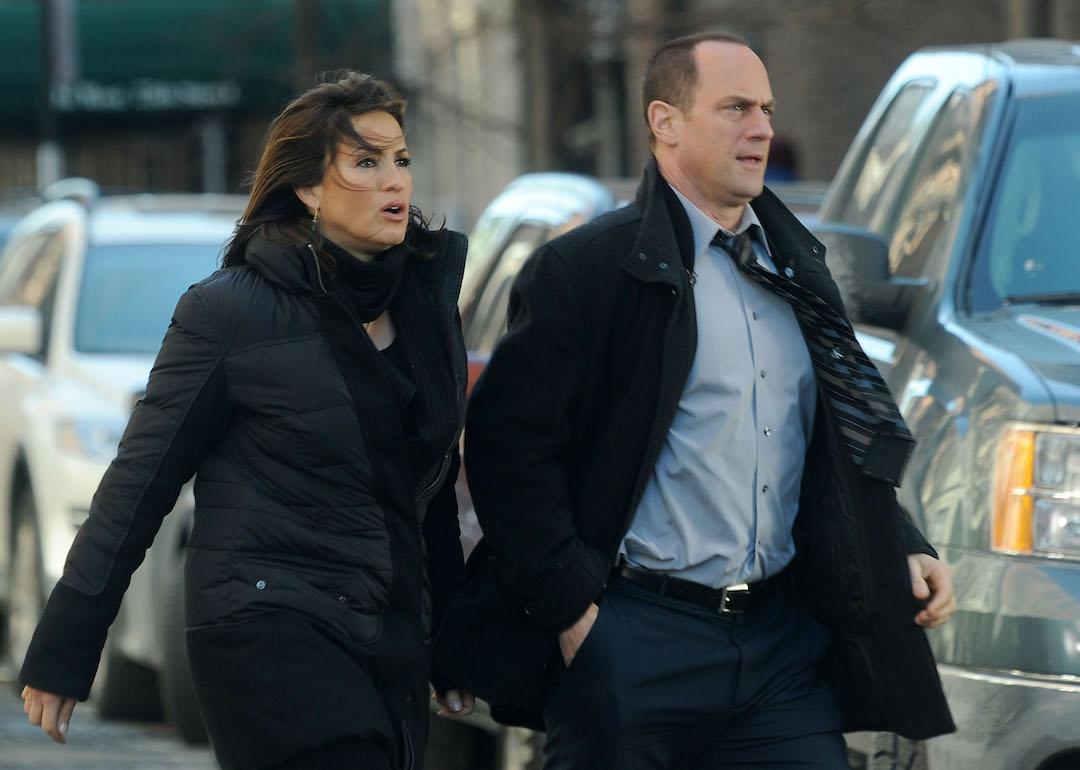
40 fascinating facts about the news industry
The nation's news industry manages to stir up passionate opinions. Americans feel strongly about their hometown newspapers, the look of a news anchor, and their need for accurate weather reports.
Stacker compiled a list of 40 fascinating facts about the news industry, consulting circulation figures, public opinion surveys, historical accounts, and, of course, media reports. In particular, it looked at how the industry has evolved, how its role is perceived, and the impact it has on everyday lives.
News has been shaped by several colossal developments: the invention of the printing press in the 15th century, new mediums of dissemination like radio and TV, and—of course—the invention of the internet, which upended the ways of television, radio, newspapers, and magazines. Traditional methods of spreading and delivering news was jolted as more people read their news online and watched it in videos, and the consequences are still unfolding. Social media like Facebook and YouTube challenge factual reporting.
Nearly 500 U.S. newspapers shut down between 1970 and 2018. More significantly, paid newspaper circulation peaked in 1987 at more than 62 million, then plunged by more than half to less than 28 million in 2018.
The availability of free content has discouraged Americans from paying for news, even if its quality and standards are inferior to those of more established media that cost money. A study in 2018 found most Americans had not paid for news in the prior year.
Throughout the decade ending in 2019, the number of newsroom jobs fell by 23%. Where there were some 114,000 reporters, editors, photographers, and camera crews working in newspapers, radio, cable, broadcast television, and digital outlets in 2008, the number dropped by some 27,000 jobs to 88,000 in those 10 years.
But as the industry lurches and stumbles, along the way, men and women have made some remarkable contributions, putting their lives on the line for news stories that mattered. Here are some fascinating facts to ponder.
Americans get most news from television and online
Research shows 41% of Americans like getting their local news on television, and 37% prefer getting it online—a roughly even split. Only 13% say they prefer a printed newspaper, and a mere 8% choose radio.
Republicans take a dim view of the media
Republicans hold a much more negative view of the news media than do Democrats. More than half say news organizations do not care about the people they cover, are unprofessional, are overly critical of America, and hurt democracy. More than half of Democrats in the same 2020 survey, on the other hand, said they thought news organizations care about the job they do, and about half said they considered news organizations to be highly professional.
Newspaper readers go online
Newspapers have moved from paper and ink. Some 43% of daily newspaper readers say they get their news digitally, as do 49% of readers of community newsletters.
Yahoo News attracts the most visitors
The nation’s most popular news website is Yahoo News, which boasted of 175 million unique monthly visitors as of August 2020. Google placed second, with 150 million monthly visitors, followed by Huffington Post with 110 million, and CNN with 95 million unique monthly visitors.
Local news takes a hit
Local isn't quite so local anymore, as news coverage is pinched by industry cutbacks and consolidation. In the United States, about half of adults say the local news they get covers an area that is not their own, such as a nearby city, while half say their local news covers the area where they live.
New York tabloid is oldest daily
The oldest continuously published daily newspaper in the United States is the New York Post, which was founded in 1801 by Alexander Hamilton. Connecticut’s Hartford Courant is the oldest continuously published newspaper, starting as a semi-weekly in 1764 and going daily in 1836.
Weather reports rank as most important news
In terms of “news you can use,” weather is the topic cited as most important for everyday life by 70% of Americans surveyed. Another 44% listed crime, and 41% listed traffic.
Fox News wins most primetime, daytime viewers
As of mid-2020, Fox News had the biggest audience in primetime—8-11 p.m.—with almost 4 million viewers in June. In October 2020, Fox News averaged 428,000 daytime viewers aged 25-54, compared with CNN, which had 361,000, and MSNBC, with an average of 243,000.
Mexico most dangerous for journalists
In 2019, 49 journalists were killed worldwide; the year before, the death toll was 80. The most dangerous countries in 2019 were Syria and Mexico, where 10 journalists were killed in each. In Mexico in particular, journalists are often put under surveillance or threatened for exposing public corruption.
Most Americans have faith in the media
A 71% majority of Americans say their local media reports the news accurately, and 65% say the news media is thorough. A majority also thinks the media keeps an eye on local political leaders and deals fairly with all sides.
US trust in media is lower than in other countries
At 29%, Americans’ trust in the news is among the lowest in the developed world. The highest trust levels were found in Finland and in Portugal, at 56% each, in a recent survey of 38 countries. At the bottom of the list were South Korea, with a 21% trust level, and France, at 23%.
Americans look to Facebook as a news source
More than four in 10 internet users in America say they get their news from Facebook. Just 17% said they got their news from Twitter, and 14% from Instagram, according to 2019 research. But two-thirds said it was traditional media that they trusted for general news and information.
CNN pioneers 24-hour news format
The first 24-hour television news network was Cable News Network, aka CNN, which debuted in 1980 and challenged the dominance of CBS, ABC, and NBC, which each aired 30-minute nightly newscasts. Mocked at first as the Chicken Noodle Network, CNN hit its stride with its live coverage of the Challenger space shuttle disaster in 1986, the three-day-long rescue of toddler Jessica McClure from a well in Midland, Texas in 1987, and live reports from the Persian Gulf War in 1991.
American colonists have dozens of newspapers
The nation’s first independent newspaper was the New England Courant, which began publication in 1721 by Benjamin Franklin’s older brother James. By the start of the Revolutionary War, the colonies had 37 independent newspapers. The first daily newspaper was the Pennsylvania Packet and Daily Advertiser, which started up in 1784.
Newspaper circulation is plummeting
Newspaper circulation in the United States at 28.6 million on weekdays in 2018 hit its lowest level since 1940, the earliest year with data. Newspaper advertising revenues sank to $14.3 billion in 2018 from $37.8 billion a decade earlier, a decline of 62%.
Number of newspaper jobs drops by nearly half in a decade
As the newspaper business has been shrinking, employment at U.S. newspapers fell by a whopping 47% in the decade from 2008 to 2018, to about 38,000 workers from 71,000. Also in 2018, a quarter of newspapers with circulation over 50,000 had layoffs. The year before, one third of them had layoffs.
Financial woes of newspaper industry are overlooked
Most Americans are unaware of the news industry’s dire financial straits. A 2018 survey found nearly three-quarters thought their local news media was faring well financially. In the same survey, just 14% said they had paid for news through a subscription, donation, or membership in the past year.
Nearly all Americans get news digitally
Nine in 10 Americans get some of their news digitally, and about half of those people get it through a mobile device like a smartphone rather than on a desktop or laptop computer. More than four in 10 get news alerts on their phones.
Starting wages for news reporters average $14.50 per hour
An entry-level news reporter can expect to earn about $29,000 a year, or $14.50 an hour, and a mid-career reporter could see an average yearly salary of about $53,000. A reporter with more than 10 years of experience could expect to make about $59,000, topping out at about $80,000 with more than 20 years of experience.
Most highly paid news anchor gets $40 million salary
The nation's most highly paid news anchor in 2019 was Sean Hannity at Fox News, who was paid a $40 million annual salary, followed in a distant second by ABC's Diane Sawyer with a $22 million salary. ABC's "Good Morning America" co-host Robin Roberts made $18 million, George Stephanopoulos of ABC's "Good Morning America" and "ABC World News Tonight" was paid $15 million, and CNN's Anderson Cooper was paid $12 million.
News anchor jobs start at $18 an hour on average
Starting out in the U.S. television market, a news anchor with less than a year’s experience will likely earn an average of about $36,000 a year, or $18 an hour. Mid-career, that average salary will reach about $60,000 and, after 20 years on the job, a news anchor can expect an average yearly pay of about $89,000.
Barbara Walters broke the gender barrier inTV news
Barbara Walters was the first woman to anchor an evening newscast, starting in 1976, when she co-hosted “ABC News” with Harry Reasoner, who did not hide his displeasure at the arrangement. The paired team went off the air after two years. The next female news anchor appeared 15 years later, when Connie Chung and Dan Rather teamed up at CBS.
News union membership peaks in 1980s
The Newspaper Guild-Communications Workers of America (TNG-CWA) labor union was founded in 1933 by journalists in New York who had realized that unionized newspaper press operators and delivery truck drivers were earning larger salaries. Membership peaked at 34,000 in the 1980s, when the union was campaigning to protect editorial workers from the potential health hazards of video-display terminals and keyboard use like eye strain and repetitive-strain injuries. Today it has about 24,000 members. New digital outlets, however, have unionized in the past 10 years.
Gwen Ifill breaks TV news race barrier
Gwen Ifill became the first Black woman to host a nationally televised news program, “Washington Week in Review,” in 1999 on PBS, and in 2004, she was the first Black woman to moderate a vice presidential debate. She later became co-anchor and managing editor of “PBS NewsHour” until she died in 2016.
First American magazines launch in 1741 but soon fail
Rival Philadelphia publishers Benjamin Franklin and Andrew Bradford put out the first American magazines in 1741, with Bradford's beating Franklin's by three days. Neither venture lasted more than a few months, but more than 100 magazines were in business by the end of the 18th century, including Pennsylvania Magazine, edited by Thomas Paine.
Congress backs public broadcasting in 1967
Passage of the Public Broadcasting Act of 1967 by Congress established the Corporation for Public Broadcasting amid a national acknowledgement of the value of educational and public service programming. The Corporation for Public Broadcasting distributed federal funds to thousands of local radio and television stations to fund noncommercial content. Today the best known in the industry are television’s Public Broadcasting Service and National Public Radio.
First news magazine covers Black women’s protest
The nation’s first news magazine, Time, published its first edition in 1923. On the cover was the Speaker of the House Joseph Cannon, who was retiring after 23 terms. Among the articles published were those on a protest by 2,000 Black women who opposed plans for a statue called “The Black Mammy of the South” to be placed in the nation’s capital, saying they did not like the reminder of slavery; reaction to the first successuful helicopter flight, and a one-cent cigarette tax in Indiana.
Nation’s first radio news show covers politics
In 1920, the first radio news broadcast was broadcast in Detroit on a station owned and operated by the Scripps newspaper family’s The Detroit News in a strategy to dominate the news market. The program was aired on Aug. 31, which was primary election day, and it announced the local, state, and congressional results. The Detroit News later launched Michigan’s first television station in 1947.
History’s Federalist Papers are penned as letters to newspapers
The “Federalist Papers,” the enormously influential 85 essays that urged ratification of the U.S. Constitution, were a series of letters written to be published by New York newspapers. First run in 1987, the essays were written by Alexander Hamilton, James Madison, and John Jay under the pseudonym “Publius.”
Investigative pioneer feigns insanity to get story
Nellie Bly pioneered investigative journalism as a reporter for the Pittsburgh Dispatch, New York World, and New York Journal. In 1887, she feigned insanity and spent more than a week undercover to expose physical abuse, rancid food, and squalid conditions at the overcrowded Blackwell's Island Asylum in New York. Bly later embarked on a 1889 race to circumnavigate the globe, which she did in 72 days, setting a record, and reported from Austria during World War I.
First Black-run newspaper denounces slavery decades before Civil War
The nation’s first Black owned and operated newspaper was Freedom’s Journal, founded by a group of free Black men in New York City in 1827. The four-page weekly circulated in 11 states as well as Haiti, Canada, and Europe; ran editorials denouncing slavery and lynchings; ran profiles of prominent Black Americans; and announced birth, death, and marriage announcements in New York’s Black community.
Rivalry at U.S. schools over oldest newspaper claims
Several U.S. colleges and universities claim to have the nation’s oldest school newspaper. The Dartmouth Gazette started as a weekly in 1799; the Yale Daily News launched in 1878; and while the Harvard Crimson began in 1873, it did not go daily until 1883. The Cornell Daily Sun that debuted in 1880 is the oldest continuously independent college newspaper, and The Johns Hopkins News-Letter from 1896 is the oldest weekly college newspaper. More recently, The Tech at Massachusetts Institute of Technology was the first college newspaper to publish online as of 1993.
Newspaper strikes transform industry
Two major newspaper strikes in New York City in the 1960s reshaped the industry in dramatic fashion. In 1962, 17,000 newspaper workers went on strike for 114 days, and a second significant walkout in 1965 lasted 140 days. The job actions helped pare the city’s daily newspapers selection down to three from 10, set production firmly on a path to computerized typesetting, and accelerated the growth and influence of local television news and all-news radio.
New York mayor takes to radio to read comics aloud
During a newspaper delivery strike in 1945, New York Mayor Fiorello LaGuardia went on the radio to read the comics aloud to the city’s children. While he had been hosting a weekly radio broadcast of news and information during the war years, his move to address children and win goodwill among New Yorkers is still considered a brilliantly astute political maneuver. In his first such broadcast, he read “Dick Tracy,” portraying an array of character voices, and in another, he read “Little Orphan Annie.”
First commercially licensed radio news reports election results
The first commercially licensed news radio program aired on Election Night in 1920. Working with the Pittsburgh Post newspaper to get the results by telephone, Station KDKA, which operated from a rooftop in Pittsburgh, announced the landslide presidential victory of Republican Warren G. Harding to about 1,000 listeners. The station was the first to be issued a radio license by the U.S. Department of Commerce, and it chose the call letters KDKA, which were the next available on the list of identifiers used for ships and marine stations.
Pioneering Black reporter poses as domestic worker for exposé
Marvel Cooke became the first Black woman to write for a mainstream, non-Black newspaper when she was hired by New York’s Daily Compass in 1950. She co-wrote a five-part series titled “I Was Part of the Bronx Slave Market” after posing as one of the city’s domestic workers who would gather at sidewalk locations looking for work and struggled with low pay and mistreatment.
Journalists of color hold small fraction of news jobs
Journalists of color hold about a third of the full-time salaried jobs at online-only news organizations and comprise about a fifth of the nation’s overall newsroom workforce, according to research published in 2019. Slightly more than a quarter of news organizations have at least one non-white person in the newsroom’s top three leadership jobs, and less than a fifth of newsoroom managers overall are people of color.
Horoscopes become a newspaper staple
Newspaper horoscopes, a staple like crossword puzzles and advice columns, got started in 1930 when Britain’s Sunday Express ran a horoscope of newborn Princess Margaret by prominent astrologer R.H. Naylor. He declared that her life would be “eventful.” One of his next forecasts about a British aircraft being in danger was taken seriously when a British airship then crashed outside Paris, killing 48 people. Naylor landed a weekly column, and its popularity spawned what became known as tabloid astrology in newspapers around the world.
Trans journalists organize
A group of about 50 journalists in 2020 launched the Trans Journalists Association (TJA) to help support the transgender community that is underrepresented in newsrooms and often misrepresented in news coverage. The organization publishes a detailed glossary of usage guidance, touching upon issues such as pronoun usage; stereotypes; and deadnames, the former names that trans people no longer use.
First Black woman covering White House snubbed by Eisnhower
The first Black woman accredited to cover the White House, Congress, and the Supreme Court was Alice Dunnigan, who was paid so little that she pawned her watch every Saturday for grocery money to last until her Monday morning paycheck. Dunnigan was Washington bureau chief for the Associated Negro Press for 14 years, starting in 1947. President Dwight Eisenhower would not call on her at news conferences for two years due to her persistent questions about civil rights. That changed when President John F. Kennedy took office and, eight minutes into his first White House news conference in 1961, called on Dunnigan and answered her question about voting rights.



